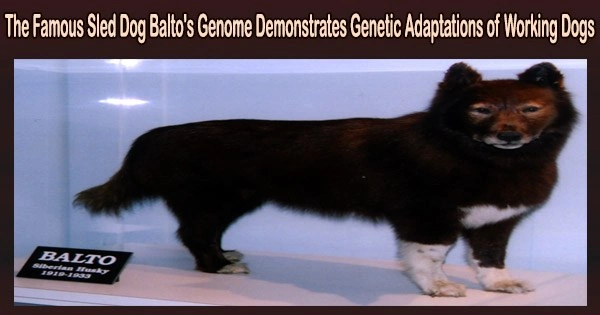Balto, the sled dog, has been immortalized in literature and film for his part in carrying vitally needed diphtheria antitoxin to Nome, Alaska, in 1925. His DNA has now allowed scientists to investigate the genetics of Alaskan sled dogs from the 1920s and compare them to present dogs.
Balto’s genome was sequenced by scientists at UC Santa Cruz as part of a big collaborative effort in comparative genomics that resulted in many studies published in the April 28 issue of Science.
The UCSC team collected DNA from taxidermied remains of Balto given by the Cleveland Museum of Natural History for the Balto project and collaborated with colleagues at Cornell University and other institutions to investigate his ancestry and genetic attributes.
“Balto’s fame and the fact that he was taxidermied gave us this cool opportunity 100 years later to see what that population of sled dogs would have looked like genetically and to compare him to modern dogs,” said Katherine Moon, a postdoctoral researcher at UC Santa Cruz and first author of the paper on the team’s findings published in Science.
Balto shared only a small portion of his complex lineage with the Siberian husky breed, according to the experts. He belonged to a population of working sled dogs that was more genetically diversified than present breeds and distinguished itself not just from modern Siberian huskies but also from modern Alaskan sled dogs.
The study discovered that his population was genetically healthier than modern breeds and possessed gene variations that may have assisted the dogs in surviving their harsh environment.
“Balto came from a population of working dogs that were different from modern breeds and were adapted to harsh conditions,” said co-author Beth Shapiro, professor of ecology and evolutionary biology at UC Santa Cruz and a Howard Hughes Medical Institute investigator.
It’s really interesting to see the evolution of dogs like Balto, even in just the past 100 years. Balto’s population was different from modern Siberian huskies, which have since been bred for a physical standard, but also from modern working Alaskan sled dogs.
Katherine Moon
The genome of Balto was compared to a dataset of 682 modern dog and wolf genomes, as well as an alignment of 240 mammalian genomes developed by the Zoonomia Consortium, which served as the foundation for the majority of the new comparative genomics studies published in the special issue of Science.
“We were able to take advantage of both the Zoonomia alignment and the huge amount of work that has gone into collecting the genomes of dogs,” said Shapiro, who is a member of the Zoonomia Consortium.
She added that the ability to align the genomes of hundreds of species so that corresponding places in different genomes may be compared is a significant advance underpinning these new investigations. Comparative genomics can then identify DNA sequences that are the same across species, indicating that these are essential sections of the genome where changes could be damaging.
“A gene that’s on one chromosome in us is on a completely different chromosome in another species,” Shapiro said. “You need a tool that can line them up so you can see which parts of these genomes are the same and which are different. Without that it’s just a bunch of genomes of species that are very divergent.”
The genome alignment tool that made this possible was developed by researchers at the UC Santa Cruz Genomics Institute led by Benedict Paten, professor of biomolecular engineering and a member of the Zoonomia Consortium.
Among the new publications are one that found thousands of sites in the human genome that are highly conserved across animals and another that shows how this knowledge could help researchers uncover genetic variations that raise illness risk.
“When we do genome sequencing of humans, it can be difficult to tell which genetic variants are significant,” explained Paten, who is a co-author of both papers. “If it’s at a highly conserved site in the genome, that’s a good sign the variant may have functional effects and increase the risk of disease.”
This approach was also utilized in the Balto research to characterize genetic variation in Balto compared to current canines. Balto and working sled dog populations had lower burdens of uncommon, potentially harmful variation than breed dogs, indicating that they represent genetically healthier populations.
The researchers also discovered protein-altering, evolutionarily constrained variations in Balto in genes involved in tissue formation, which could be beneficial adaptations.
“Balto had variants in genes related to things like weight, coordination, joint formation, and skin thickness, which you would expect for a dog bred to run in that environment,” Moon said.
Raised in the kennel of breeder Leonhard Seppala, Balto belonged to a population of small, fast sled dogs imported from Siberia that became known as Siberian huskies. The modern Siberian husky breed, however, is quite different from Balto and from modern sled dogs.
In addition to Siberian huskies and Alaskan sled dogs, other living dog lineages that share common ancestry with Balto include Greenland sled dogs, Vietnamese village dogs, and Tibetan mastiffs.
“It’s really interesting to see the evolution of dogs like Balto, even in just the past 100 years,” Moon said. “Balto’s population was different from modern Siberian huskies, which have since been bred for a physical standard, but also from modern working Alaskan sled dogs.”
One intriguing attribute discovered in Balto’s DNA is a stronger ability to digest starch than wolves and Greenland sled dogs (an isolated population), but not as good as modern dogs, which digest starchy meals readily.
Researchers were also able to use Balto’s genome to reconstruct his physical appearance, including his stature and coat color, in more detail than even historic photos could reveal.
“This project gives everyone an idea of what’s starting to be possible as more high-quality genomes become available to compare,” Moon said. “It’s an exciting moment because these are things we haven’t done before. I feel like an explorer, and once again Balto is leading the way.”
Another paper from Shapiro’s lab and the Zoonomia Consortium, in collaboration with the San Diego Zoo Wildlife Alliance and other institutions, used genomics to predict which mammal species are more likely to face extinction.
Genomic analysis can uncover indications of inbreeding as well as other indicators of a population on the verge of extinction. Although ecological data are the strongest indicators of extinction danger, genetics can assist in identifying species that require additional attention.
“In conservation, there are more species that need attention than we have time or resources to study, and it turns out that just having one good DNA sample can be enough for us to say either they’re probably alright, or now we need to focus on this species,” Shapiro said.
















